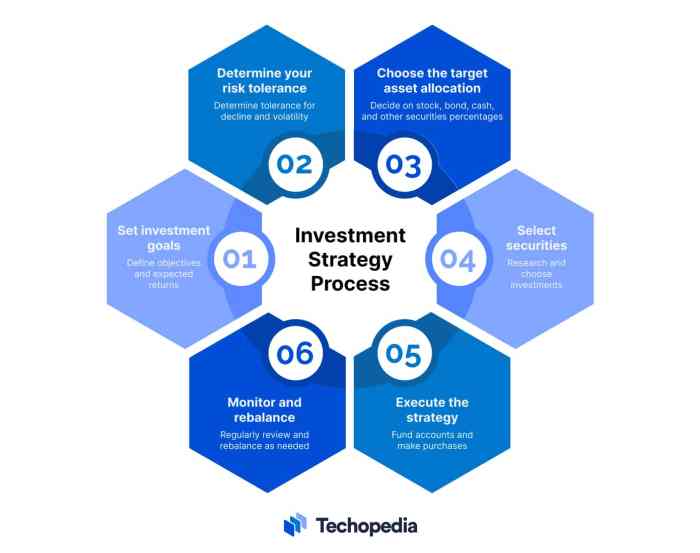Investment strategy sets the stage for financial success, blending key concepts like value investing and risk management in a dynamic dance of wealth creation. Get ready to dive into the world of savvy financial decisions with a twist of style!
From defining investment strategies to exploring risk management techniques, this narrative unfolds like a thrilling plot, showcasing the power of informed decisions in the ever-evolving landscape of investments.
Overview of Investment Strategy

An investment strategy is a plan or approach used to guide an individual or institution in making investment decisions. It is crucial in financial planning as it helps determine the best way to allocate resources to maximize returns while managing risk.
Types of Investment Strategies
- Value Investing: Focuses on finding undervalued stocks or assets with the potential for long-term growth.
- Growth Investing: Involves investing in companies that are expected to grow at an above-average rate compared to the market.
- Income Investing: Aims to generate a steady income stream through dividends, interest payments, or other sources.
Examples of Successful Investment Strategies
- Warren Buffett’s Value Investing: Buffett is known for his long-term value investing approach, focusing on solid companies with strong fundamentals.
- Ray Dalio’s All Weather Strategy: Dalio’s strategy aims to create a balanced portfolio that performs well in various economic conditions.
Key Components of a Solid Investment Strategy
- Diversification: Spreading investments across different asset classes to reduce risk.
- Risk Management: Implementing strategies to protect investments from potential losses.
- Research and Analysis: Conducting thorough research and analysis before making investment decisions.
Risk Management in Investment Strategy
Risk management is a crucial component of developing a successful investment strategy. By effectively managing risk, investors can protect their capital and increase the likelihood of achieving their financial goals. One of the key ways to mitigate risk in an investment portfolio is through diversification.
Diversification involves spreading investments across different asset classes, industries, and geographic regions. By not putting all your eggs in one basket, you can reduce the impact of a single investment’s performance on your overall portfolio. This helps to minimize the risk of significant losses if one investment underperforms.
Asset Allocation
Asset allocation is another important risk management technique. By dividing your investments among different asset classes such as stocks, bonds, and cash, you can further reduce risk. Different asset classes have varying levels of risk and return potential, so a well-balanced allocation can help manage overall portfolio risk.
Hedging
Hedging is a strategy used to offset potential losses in one investment by taking an opposite position in another. For example, an investor may use options contracts to hedge against potential losses in a stock position. While hedging can reduce risk, it also comes with costs and may limit potential returns.
Stop-Loss Orders
Stop-loss orders are a risk management tool used to automatically sell an investment if it reaches a predetermined price. This helps limit losses and protect profits by setting a clear exit point. However, stop-loss orders can also be triggered by short-term market fluctuations, so it’s essential to set them at appropriate levels.
Overall, effective risk management strategies can have a significant impact on investment outcomes in various market conditions. By incorporating diversification, asset allocation, hedging, and stop-loss orders into an investment strategy, investors can better protect their capital and navigate the ups and downs of the market.
Long-Term vs. Short-Term Investment Strategies

When it comes to investing, you’ve got two main options: long-term and short-term strategies. Let’s break it down and see what each one brings to the table.
Advantages and Disadvantages of Long-Term Investment
Long-term investing is all about patience and consistency. You buy and hold onto investments for an extended period, typically years or even decades. The advantages include:
- Opportunity for compound interest to work its magic over time
- Less stress from market fluctuations as you ride out short-term volatility
- Potential for higher returns compared to short-term investments
However, the disadvantages of long-term investing may include:
- Lack of liquidity if you need to access your funds quickly
- Potential to miss out on short-term gains from market timing
Advantages and Disadvantages of Short-Term Investment
Short-term investing involves buying and selling assets within a shorter time frame, often days, weeks, or months. The advantages of this approach are:
- Potential to capitalize on quick market movements and short-term trends
- Ability to quickly access your funds when needed
- Opportunity to take advantage of short-term market inefficiencies
On the flip side, short-term investing comes with its own set of disadvantages:
- Higher risk due to increased market volatility and uncertainty
- More time and effort required for active trading and monitoring
Impact of Economic Factors
The effectiveness of long-term versus short-term investment strategies can be influenced by various economic factors. For example, during periods of economic stability and growth, long-term investments may perform well due to the compounding effect. On the other hand, in times of economic uncertainty or recession, short-term strategies that capitalize on quick gains could be more advantageous.
Real-World Examples
One classic example of a successful long-term investment strategy is Warren Buffett’s approach of buying and holding strong companies for the long haul, such as Coca-Cola and Apple. On the short-term side, day traders who capitalize on intraday price movements in the stock market can also achieve significant profits if they have the skills and discipline to execute their strategies effectively.
Implementing an Investment Strategy
Investing can be a complex process, but implementing a solid investment strategy can help you achieve your financial goals. From setting your investment goals to constructing a well-diversified portfolio, there are several key steps involved in implementing an investment strategy. It’s important to regularly review and adjust your strategy over time to ensure it remains aligned with your financial objectives. Monitoring the performance of your investments and making informed decisions based on market trends is crucial for success. Here are some tips to help you stay disciplined and committed to your investment strategy despite market fluctuations.
Setting Investment Goals
Before diving into investing, it’s essential to set clear and achievable investment goals. Whether you’re saving for retirement, a major purchase, or simply looking to grow your wealth, defining your objectives will guide your investment decisions.
Portfolio Construction
Constructing a well-diversified portfolio is key to managing risk and maximizing returns. By spreading your investments across different asset classes, industries, and geographic regions, you can reduce the impact of market volatility on your overall portfolio.
Regular Review and Adjustments, Investment strategy
Regularly reviewing your investment strategy and making adjustments as needed is crucial for long-term success. Economic conditions, market trends, and personal financial goals may change over time, requiring you to adapt your investment approach accordingly.
Monitoring Performance
Monitoring the performance of your investments is essential for evaluating the success of your strategy. Keep track of key performance metrics, such as returns, volatility, and correlation, to assess how well your investments are performing relative to your goals.
Staying Disciplined
Staying disciplined during market fluctuations can be challenging, but it’s important to stick to your investment strategy and avoid making emotional decisions. Remember that investing is a long-term endeavor, and short-term fluctuations should not derail your overall financial plan.





